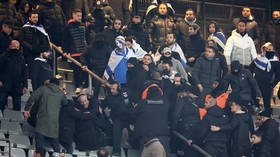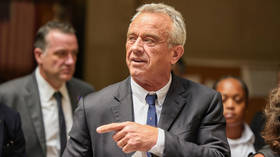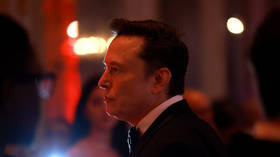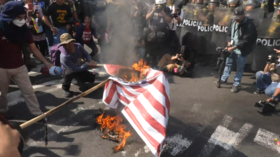Russia’s year in the wake of Lehman Brothers

It’s a year ago this week that the global financial circulation system had its closest near death experience in a generation. That saw a chain of events which haven’t left Russia unscathed.
Ricochet hits Russia – Currency first
Russia saw the Lehman collapse come in the immediate wake of an incipient capital flight and the global crude price plummet. In early august the Russian currency was in the rudest health it had been in for 10 years at a rate of about 23.50 to the U.S. dollar. By early November the only thing holding it back from freefall, at a rate of about 29 to the dollar, was the Central Bank of Russia, using its funds to defend the indefensible.
By then everyone else was in sellout mode when it came to the Rouble. Everyone, from oligarchs and their leveraged empires, to the man on the street, which in Moscow saw money changers doing a roaring trade, wanted dollars. Prime Minister Putin stated that he wasn’t going to sit by and watch people have their life savings wiped out overnight.
The net result was what came to be known as the Central Bank’s ‘managed devaluation’ of the Russian currency – A one way bet against the Russian currency lasting from early November until early February this year.
Comings and owings
While that one way game against the Rouble unfolded over the lead up to the New year holidays, and beyond, Russia’s oligarchs were finding that the debt they had taken on to fuel their acquisitions was coming at a cost they simply could no longer pay. Early signs included Oleg Deripaska’s diverse empire buckling under a series of margin calls. But there were very few who weren’t in major financing trouble, owing billions of dollars to global banks. That meant that, with global lending having dried up, the only funding in town was that being made available by the government.
Early in 2008 Russia had been earning an estimated billion dollars a day as oil climbed towards its zenith. Russia had paid off its debts and was on a sounder financial footing than almost any other global economy. The Finance Ministry had fought tooth and nail to build up a reserve fund to keep some form of leash on Russia’s then rampant inflation, or for those moments of desperate need. If Alexei Kudrin’s men and women hadn’t succeeded in sterilising inflation they had succeeded in creating the buffer needed.
Crash and burn or shoulder to shoulder?
The only question was ‘should the government buy in or let it all come crashing down?’ After reports of some conflict within the administration, the ‘buy in’ school won the day. The billions, which only months previously had been the worlds third largest reserves, became available for the rainy day.
The problem Russia and its banking system faced was unlike much of the rest of the world insofar as Russia’s major banks have barely any exposure to toxic derivatives, or the sub prime real estate loans which have bought major global banks to their knees. Russian consumers are not heavily indebted, with only a small number of real estate transactions involving mortgages. The Russian variety of the credit crunch involves massive exposure to major companies and magnates who owe billions to the rest of the world to finance their purchases and plans.
In addition to the billions being used to manage the soften the inevitable decline of the Rouble, the most pressing problem was sorting out how to refinance the magnates and enterprises which made up most of corporate Russia. To wean them off their dollar and euro denominated loans and plug the gap with Roubles. Billions were allocated to Vnesheconombank, the hitherto barely known state development bank, with billions more thrown at Sberbank and VTB. From there the instruction was to get the billions out and into the hands of those who needed to pay off big due debts from somewhere else.
No longer waving but drowning
Those owing included the crème de la crème of Russia’s business world – every man jack of them. After 10 years of economic expansion there was barely one which wasn’t planning major expansions or new projects in Russia, or looking to go global with borrowed merger and acquisition funds. There were borrowings for massive energy development projects, borrowings for international buyouts of steelmakers in the US, of nickel mines in Australia, chromium plants in South Africa, automakers in Europe, borrowings for takeovers of luxury retailers, and borrowings for partner buyouts of soured relationships in Russia. There were property developers, communications giants, and luxury restaurants. There were carmakers, grocery purveyors, and white goods importers. All desperate for funding.
In a few short months the vast bulk of those owing large sums internationally, found themselves able to fend off their creditors or, more rarely, merged into something that could. That added to the hammering being worn by the Rouble, with every last infusion of cash into many troubled firms going straight into dollars or other global currencies to retire debt.
The battering of the Rouble comes to an end in the first week of February when the Central Bank draws a line in the sand at 41 Roubles to its currency basket, which effectively meant a rate of about 36 to the US dollar. It stated that it was more than prepared to be aggressive in defending its new line.
Economy in free fall
The long period of managed currency devaluation sees almost all investment activity in Russia come to a screaming halt. Building sites, most notably the skyscrapers of Moscow City, but also including hundreds of residential and commercial property developments reflect the end to the easy days.
Elsewhere major employers including steelmakers, miners, energy employees, and retail workers were looking to reduce headcounts. As domestic demand shuddered under the weight of companies no longer able to afford to buy, prices for Russia’s global exports slumped. The most notable was crude oil, which collapsed from a peak of more than $147/bbl to less than $35, but with global demand for steel, coal and Russia’s other major commodity exports, including fertilizers and nickel down. OPEC announced production cuts with a view to bringing crude back to about $70/bbl.
Job losses mounted, but with many saying that worse could be expected. Russian consumption, which had become increasingly prominent at the height of the boom went into free fall, adding to pressure on expansion plans of retailers. The headline making real estate boom came to an end with apartment prices down by as much as 30% in dollar terms by February.
Budgeting to batten down
The government, well aware of the mounting outlays, the diminished, but still considerable size of its reserves, and the need to prepared for the possible worst, called for the budget to be recast to reflect an average oil price of about $40/bbl. In addition to trying to work out how to pump enough into infrastructure spending to keep the economy as robust as it could, the government is making clear that it will protect ordinary Russians, with leaders noting that ordinary Russians weren’t to blame for the crisis and would be protected. For the first time in a decade Russia is now looking to become a global borrower.
At a corporate level capital expenditure budgets are slashed to the bone as companies focus on immediate needs, including major steelmakers idling plant and equipment to minimize costs. At a retail level, consumers trim expenditure back to bare minima.
Rock bottom
Russia’s stockmarkets, which only a year previously had been amongst the most buoyant in the world hit their nadir in February and March, with shares in major companies getting prices only a fraction of what had been considered fair value just a short time earlier. They have some support from the central bank and Vnesheconombank, which has entered the market trying to buy up shares in blue chips in order to stabilize the situation. Political leaders acknowledge that unemployment will worsen. 1Q 2009 corporate filings see Russian companies posting some of the worst results in a decade.
When things are darkest something of a floor appears. The Rouble holds firm and gets support from the oil price, which rebounds after it becomes apparent that OPEC’s production cuts are having effect. The Russian banking system holds together, and manages to shift funds through to many of the companies needing to restructure.
Scraping along the bottom
From the end of 1Q 2009 the global outlook begins to stabilize with the massive economic stimulus measures unveiled in the US and China showing some likelihood of putting a floor under global demand. At the same time concerted action by global central banks starts to free up the global financial system, bringing interbank rates down. The immediate effect in Russia is barely noticeable, but the future outlook is improved as China’s buying of commodity prices sees copper and other key base metal prices rally.
This helps bring some focus back to the heavily oversold Russian stockmarkets enabling a rebound in the RTS and Micex for most of 2Q, which flows through to an easing of the liquidity situation and company valuation concerns. It isn’t the boom days but its like manna from heaven after the free fall of late 2008.
The economic fundamentals are still deteriorating with production and GDP declines amongst the worst ever recorded for 1H 2009. The only upside is that inflation, Russia’s bugbear for a decade falls to zero in July. Crude prices hold in the $60-70/bbl range, well above the basis for the revised Russian budget.
Green Shoots
Half year results for Russian companies continue to see downside, but not at the pace of 1Q. The same is born out by official GDP and production data. Talk in political circles starts to refer to ‘green shoots’ as the sliding US dollar pushes crude above $70/bbl and gold soars to beyond $1000/oz. The restructuring of debt of major Russian companies continues. Signs that something of a floor has appeared under the real estate market appear, retail sales begin to show signs of stabilizing. Another local underpinning is infrastructure expenditure, always slow to start showing effect, which was beefed up during the winter months, is now showing up in GDP data.
The Rouble is holding relatively firmly at about the 31-31 to the dollar mark. Despite concerns about its possible devaluation amidst a ‘second wave’ of financing issues general sentiment starts to indicate that the bottom has been reached if not past. More companies begin to look and sound more upbeat in their future outlooks.














